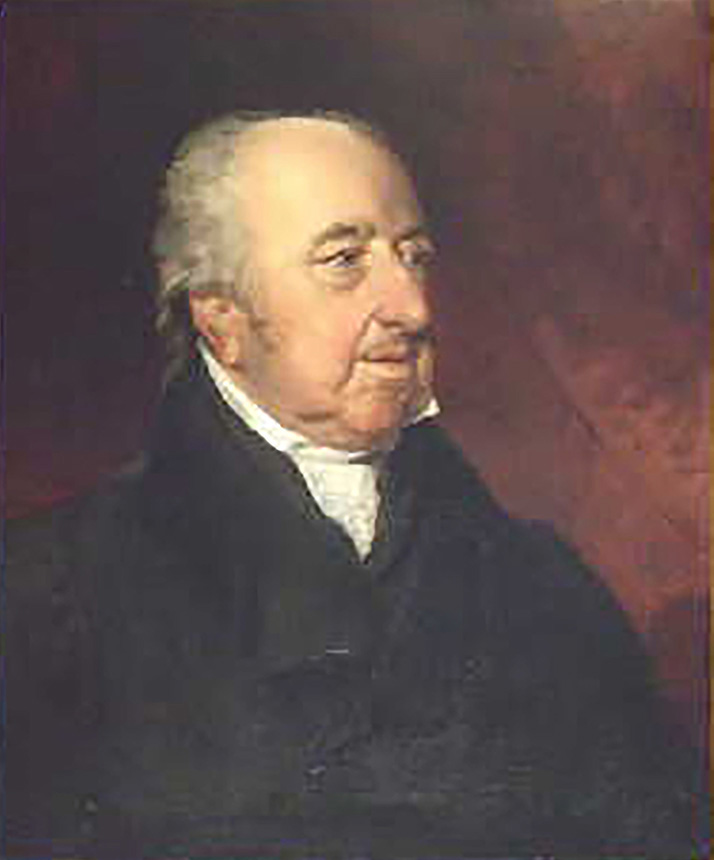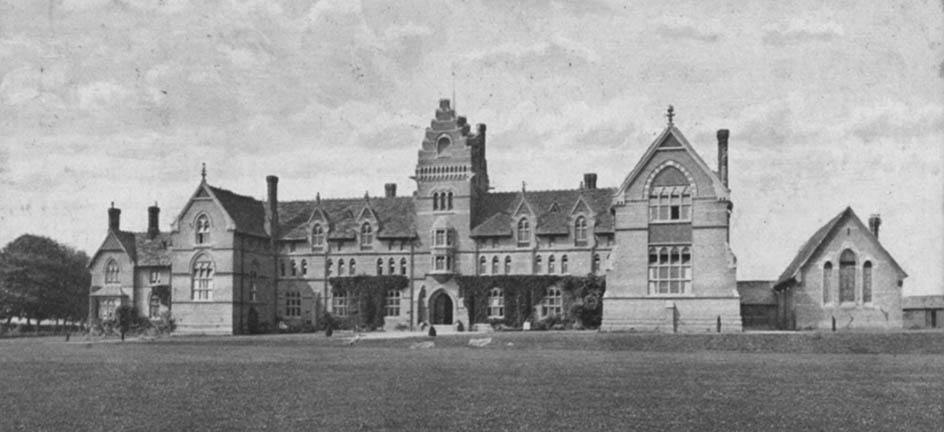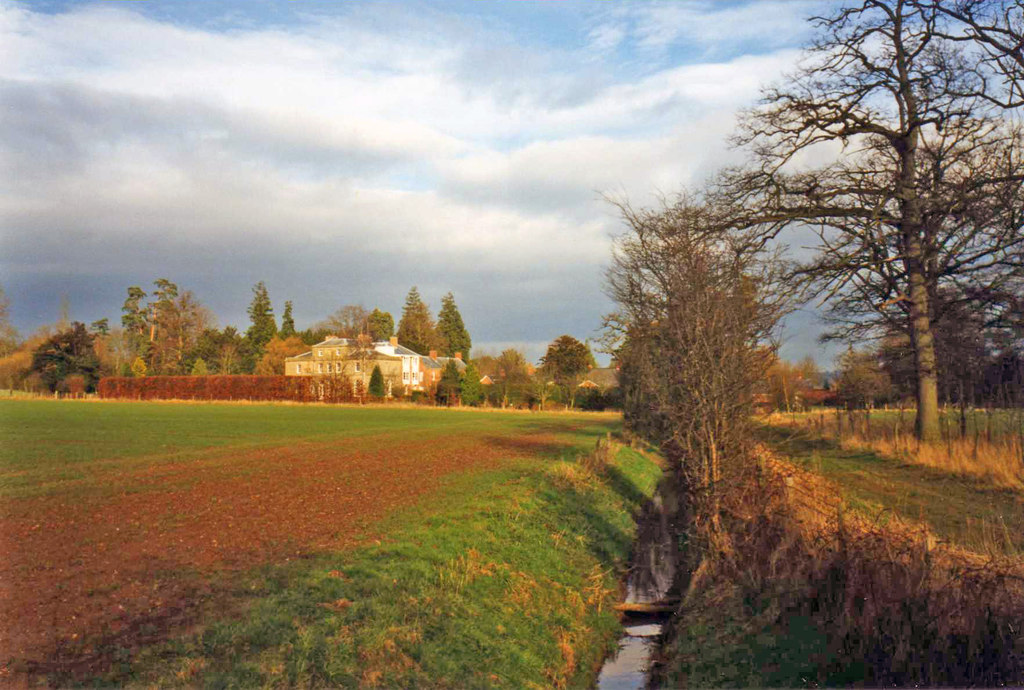St Dubricius' was extensively restored in 1853-4 by J P Seddon, a contemporary and friend of the Rev William Poole, parish priest of Hentland and Hoarwithy from 1854 until his retirement in 1901. Rev Poole was immensely wealthy and owned large estates in Herefordshire, Radnorshire, Durham, Northumberland, and Devonshire. He died in 1902 at the age of 83. Poole never married.
The Rev William Poole was born in 1819, the fourth son of Edward Poole (1775-1848) of Stretton Grandison, Herefordshire and his wife Katherine, nee Biddle. Edward Poole was a prosperous member of the landed gentry; who in 1845, among other properties, owned 'Barrs Court', a small estate on the outskirts of Hereford, where ten years later the Hereford and Gloucester and the Hereford and Shrewsbury railway companies were to build their joint mixed gauge Hereford railway station.
In 1814-21 Edward Poole had engaged Robert Smirke, who was working on Eastnor Castle, to design the front of the Stretton Grandison family home, 'The Homend', a building with its origins in the 17th century. Smirke is best known for designing the main block and facade of the British Museum (1823–46). From 1817 Poole had landscaped the Homend Estate.
Edward and his wife Katherine had seven children: James (b 1811), Charlotte (b 1812). Frances (b 1813), Edward (b 1814), Catherine (b 1815), Richard (b 1817) and William (b 1819)
William Poole's one known leisure activity was archery. The 19th century archery revival, encouraged by Queen Victoria, led locally to the formation of the Herefordshire Archery Association of which William became a member. The associations were open to both men and women and the sexes mingled on the same grounds although did not directly compete. When the Herefordshire and the Worcestershire Associations played each other at a friendly competition at Witley Court in 1850 each picked twelve gentlemen and twelve ladies were chosen by each as representative of their respective counties. Young Rev William Poole's score of 31 was modest.
At the second meeting of the Herefordshire association in August 1851 at Hendre, Monmouth, (the home of the Rolls family) teams from the great houses of the area competed. Here the Rev William Poole achieved glory; playing for the Homend team he won the first gentleman's prize for hits.
William was not the first member of his family to become a priest. His great-great-great-great-great-grandfather (7 generations) Richard Pool, had been baptised in Tarrington, Herefordshire in 1553. Richard's son, also called Richard, had been baptised in 1579. His son, another Richard (William's great-great-grandfather) had been born in 1623. His son, Rev James Poole (1649-1721) became a canon of Hereford in 1684, and vicar of Stretton Grandison.
James Poole married Anne Jauncey on 12 June 1683. Anne was an heiress and seems to have brought considerable wealth to the family. The Jauncey family had held the manor of Whitwick for several generations, having purchased it in the early 17th century. Richard, the eldest son of Anne and James, bought the Homend estate in 1703, and added a brick extension onto the existing half-timbered house. Richard Poole died before 1728. Their second son, James, followed his father into the clergy and in 1721 'inherited' the role of Vicar of Stretton Grandison from his father. There was also a third son, Francis, about whom little is known.
Anne and James' fourth son - William's great grandfather Edward Poole (1690 - 1776) gained his B.A. in 1713, his M.A. in 1716 and was ordained deacon at Ely in 1724 and priest in 1725. He became vicar of Caynham, near Ludlow, a position he held in 1749. His wife Mary Wadely (1706-1772) came with a thousand pound dowry - a considerable sum in the 1740s. Mary died in 1772 in Caynham.
Rev William Poole's family epitomised the English landed gentry in the 19th century - land; the church and the army. His great uncle Captain James Poole had been paymaster for troops in Ireland. William's great aunt Mary Poole (1741-1821) had married as her second husband Ralph Cope Hopton (1726-1797), a descendant of Sir Richard Hopton of Rockhill. Ralph Cope Hopton himself was vicar of Bishop's Frome in Herefordshire and a Prebendary of Hereford cathedral.
The Hopton family had lived at Canon Frome, the neighbouring parish to Stretton Grandison for several generations, the succession often being through the female line. The Canon Frome estate was one of the largest in the county
William Parsons, only surviving son of John Parsons MP of Kemerton Court in Gloucestershire, took the name of Hopton by Royal decree of 21 March 1817 in order to inherit the Canon Frome estate. William (Parsons) Hopton was married to Mary Graves, but when she died he married as his second wife, Anne Poole, the daughter of William's Great uncle James Poole, re-establishing the link between the area's major landowning families. William Parsons' sister, Frances, married Rev Joseph Biddle. Rev Joseph Biddle, Vicar of Beckford with Ashton under Hill in Worcestershire from 1768 to 1797 and of Bishop's Frome in Herefordshire from 1797 to his death in 1826. Frances and Joseph's daughter Katherine Biddle, was Rev William Poole's mother.
In 1825 William (Parsons) Hopton retired to his paternal estate at Kemerton in Gloucestershire, leaving his Canon Frome estate to his heir, John, his son by Mary Graves. John Hopton became vicar of Canon Frome too: in 1870-72 John Marius Wilson's Imperial Gazetteer of England and Wales noted that 'Canon-Frome Court is the seat of the Rev. John Hopton'.

Rev Joseph Biddle: grandfather
William Poole attended Rugby School, appearing in the 1830 register as 'Poole, William, son of E. Poole, Esq. Homend, Ledbury, aged 10, Oct 10.'. He followed his older brothers, James who entered Rugby in 1822, and Richard, in 1826. Another brother, Edward, had died in 1828, aged just 14. William matriculated to Oriel College at Oxford University in 1837 at the age of 17. He studied Literae humaniores (Lit Hum) nicknamed 'greats', rather than theology, and received his B.A. in 1841. The Bishop of Hereford, Thomas Musgrave, ordained William Poole a Deacon On Sunday 2nd June 1844 at All Saints Church in the city.
'Rev William Poole, Oriel College'was among those receiving the degree of Master of Arts in a congregation at Oxford on Thursday 27th February 1845. Although styled 'Reverend', William had probably not yet been ordained a priest, an event however which, according to Crockfords, did occur in that year.
In the 1840s Hentland was one of four perpetual curacies attached to the vicarage of Lugwardine: the others being Little Dewchurch, Llangarran, and St. Weonards. The perpetual curate was the Rev Kyrle Ernle Aubrey Money who retired in 1854. The Rev William Poole was presented to the living of Hentland on 18th February 1854. The patron was the Rev Hugh Hanmer Morgan as vicar of Lugwardine. The Rev Morgan had been Vicar of Lugwardine since 1805, and in that role had been patron on 17th May 1849 on the institution of the Rev Kyrle Ernle Aubrey Money to Hentland on 17th May 1849. Like Rev Money, Rev Poole was a 'perpetual curate'. He was, from 1857, a prebendary of Hereford cathedral.
The oldest of the Poole brothers, James, studied law: admitted to the Inner Temple 15 Nov 1833, it is not clear that he ever practised. James married Grace Anne Hopton at Canon Frome in August 1841. Grace Anne was the eldest daughter of the Vicar of Canon Frome, Rev John Hopton of Canon Frome Court. Another link was forged betwen the Hoptons and the Pooles. As if that wasn't enough, in October 1845 William's sister Frances married their cousin James Michael Parsons Hopton, the son of Rev William Parsons Hopton and their aunt, Anne Poole.
The second brother, Richard, clearly had serious problems, and in 1861 was in the care of a physician, in a residential home in Bedminster Bristol. In 1891, aged 70, he was a 'rest patient' at Clarence House in Portishead, living on his own means' and classified as an 'imbecile'. Richard died at Portishead 9th November 1899 with effects to the value of £24,981. His estate went to his next of kin, William.
William's older sister, Catherine, became a nun in middle age, and in 1871 was sister-in-charge of the small convent at St Martin's Church 'Home of Mercy', Salisbury, Wiltshire. In 1881 James' widow, Grace Anne Poole, aged 73, was listed at part owner of the 'House of Mercy' In Bisley, Stroud. Living in the house was Catherine Poole, her 65-year-old sister-in-law. listed as a 'sister of mercy'.
Poole was immensely wealthy and owned large estates in Herefordshire, Radnorshire, Durham, Northumberland, and Devon. As his father had done with the family home, Poole naturally felt it appropriate to engage the services of a first class architect when he saw a requirement.

Hereford College
The Rev Poole had an abiding interest in education and was in communication with Frederick S. Warren, traveling secretary of the National Society for Promoting the Education of the Poor in the Principles of the Established Church. The Reverend Poole was secretary of the Hereford Diocesan Board of Education. He was also an original shareholder of the Hereford Middle Class College; an institution established 'to give to the sons of farmers, tradesmen, and others a good sound and useful education on moderate terms.'
Poole's wealth was of considerable help to the undertaking; and he donated the land on which the school was built. The large gothic structure, designed by F R Kempson, which resulted, served a number of educational purposes over time. The School opened as Hereford County College and School of Science, Commerce and Agriculture. According to the 1895 Kellys Directory it – 'educates boys at a modest cost on the public school system – 90 boys of whom 60 are boarders.
For many years it was Herefordshire (Ladies) Teacher Training College, before being used by the Royal National College for the Blind.
Seddon designed the vicarage in 1858, the school in 1859, and rebuilt the chapel of ease at Hoarwithy as an elaborate Italianate church, St Catherine's, in 1874. Seddon added the north porch to St Dubricius'; and designed the vestry in 1866, and the lychgate in 1898, when other restoration was carried out at the cost of £600.
When St Catherine's was rebuilt, the seasoned oak for the sanctuary stalls came from Poole's Homend estate and was carved by Harry Hems of Exeter apparently under Rev Poole's close scrutiny.
The 1881 census records Poole as being aged aged 61 and 'Vicar of Hentland', resident the Hoarwithy Hentland Vicarage. His actual description remained what it had always been, and the 1891 census records him correctly as 'perpetual curate of Hentland', aged 71. The term 'perpetual curate' is a curiosity within the Church of England
Perpetual curacies had their origins in chapels-of-ease to churches held by monasteries, where the houses wanted to retain the tithes for themselves. With the population growth in the 19th century large numbers of new churches and parishes were needed. Many former chapelries were elevated to parish status, and the the parish priests of new parishes were legally perpetual curates.
After 1868 perpetual curates could call themselves vicars. Charles Dodgson, the father of CL Dodgeson (Lewis Carroll) was perpetual curate of All Saints' Church, Daresbury in Cheshire.
Compared to rectors and vicars perpetual curates tended to be of uncertain social standing. They were also much less likely to be adequately paid. Neither of these considerations would have been of much concern to the wealthy and socially assured William Poole.
Poole died in 1902 at the age of 83: he never married.
Poole's papers are in the collection of the Kenneth Spencer Research Library at the University of Kansas.
